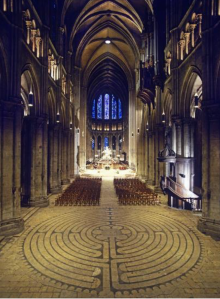What’s a labyrinth and why would you walk one?
A labyrinth is a circuitous and sometimes complex path that one walks from an entrance to the center, then back again, oftentimes used as a walking meditation. It is not a maze, with mental challenges and blind alleys. Sometimes people incorrectly refer to mazes as labyrinths.
Lauren Artress, the founder of Veriditas, describes the labyrinth as is “a tool to guide healing, deepen self-knowledge, and empower creativity” (Artress 1995: 20).
There is no “right” way to walk the labyrinth; there are no “right” thoughts to have. Let your experience be your own. The path of the labyrinth is like the path of life – with twists and turns, feelings of being lost, encounters with others in your path, a thrill of pleasure as you approach the center and sometimes a flash of insight before you leave. Some enter the labyrinth with a problem to solve or an intention to change something in their lives. One person said “In this space I release my fears and remember who I truly am.”
People find that they need a time and place to reflect … a chance to step out of the busy-ness of ordinary life … so they can listen to the inner voice to help them deal with the joys and sorrows, the hopes and fears and disappointments of everyday life. Stepping into the labyrinth and following its twists and turns seems to provide that opportunity to reflect, to ask questions and to discover answers.
Ancient Labyrinths Around the World
Labyrinths and/or labyrinth carvings in rock and stone, date back more than 4,000 years. Like Stonehenge and the Pyramids, they are special geometric forms that define sacred space. They have been found in every continent in the world except Antartica. There are labyrinths etched in Roman mosaics, in caves, cliffs and tombs, on stone floors of medieval churches, and cut into turf.
The oldest recorded labyrinth is the 7-circuit “Classical Labyrinth,” which is also referred to as the “Cretan Labyrinth” and “Minoan Maze,” The photo above is a petroglyph version of this type labyrinth. This type design was found etched on the back of a clay tablet from Pythos, Greece around 1200 B.C.E. “ (Bohntinsky 2016: 212). Yet, it is found universally. “This universality of the labyrinth shows that there exists something common, shared by all ancient cultural systems, and what is more, there exists something fundamentally central, seeing it as the symbol of our origin and ultimate destination” (Conty 2002: 15).
 One of the most famous labyrinths that comes to mind is the mythological labyrinth of Theseus and the Minator from ancient Greece (pictured here is a coin from 5th century BCE from Konossos, Crete). This huge labyrinth/maze was supposedly built underneath the palace of King Minos by the architect Daedalus. Here is an interesting TED-Ed Talk that discusses the science and mythology of this labyrinth and the Minotaur.
One of the most famous labyrinths that comes to mind is the mythological labyrinth of Theseus and the Minator from ancient Greece (pictured here is a coin from 5th century BCE from Konossos, Crete). This huge labyrinth/maze was supposedly built underneath the palace of King Minos by the architect Daedalus. Here is an interesting TED-Ed Talk that discusses the science and mythology of this labyrinth and the Minotaur.
A more “recent” labyrinth is the eleven circuit labyrinth tiled on the floor of the sanctuary in Chartres Cathedral, France, built in the 1200’s and is still in use today.
Ancient Labyrinths in the Southwest
Since the Labyrinth Resource Group is based in New Mexico, we are especially proud of the rich heritage we have with early labyrinth rock art. However, the origins of labyrinth symbols in the American Southwest is still shrouded in mystery. Most of these symbols are likened to much older designs from labyrinths in Europe, Asia and Africa, but there is no archeological evidence to trace these intercontinental connections. These symbols form important themes in the traditional stories of the Hopi and early pre-Pueblo peoples.
Winnemucca Lake, Nevada
 The oldest dated rock art representations of labyrinths found on the rock surfaces at Winnemucca Lake, Nevada dates back to 10,500‐14,800 BP (Benson et.al 2013). Some of the labyrinth design and sun motifs are similar to those observed on slabs of Bronze Age Megalithic tombs and rock surfaces in England, Ireland, Norway, Sweden and Italy (Coles and Harding 1979 175‐176, 264). Source: Dept of Archeology, University of Kerala, India “Labyrinths in Rock Art: Morphology and Meaning with Special Reference to India,” 2015. Photo by Larry Benson, University of Colorado
The oldest dated rock art representations of labyrinths found on the rock surfaces at Winnemucca Lake, Nevada dates back to 10,500‐14,800 BP (Benson et.al 2013). Some of the labyrinth design and sun motifs are similar to those observed on slabs of Bronze Age Megalithic tombs and rock surfaces in England, Ireland, Norway, Sweden and Italy (Coles and Harding 1979 175‐176, 264). Source: Dept of Archeology, University of Kerala, India “Labyrinths in Rock Art: Morphology and Meaning with Special Reference to India,” 2015. Photo by Larry Benson, University of Colorado
Casa Grande National Monument, AZ
One of the world’s most controversial labyrinths exist in Arizona’s Casa Grande ruins, now a national monument. In 1694, Padre Kino set out to find the legendary “Great House” on the Gila River. He discovered a 4-story adobe building. On the structure’s north wall there is a 7 circuit classical labyrinth design etched in the plaster. It bore striking similarities to labyrinth designs on 2000 year old Cretan coinage. There is historical support that this labyrinth may be pre-Columbian.
Tonto National Monument, Roosevelt AZ.
 This monument features a 40 room cliff dwelling in Gila County, AZ. In its Upper Ruin (Room 14), there is an etching of a labyrinth similar to the one at Casa Grande, some 60 miles to the southwest. It was excavated in 1940 by the National Park Service archeologist Charlie Steen. It dates back to the pre-Columbian era of the people of the Salado culture. Photo by National Park Service.
This monument features a 40 room cliff dwelling in Gila County, AZ. In its Upper Ruin (Room 14), there is an etching of a labyrinth similar to the one at Casa Grande, some 60 miles to the southwest. It was excavated in 1940 by the National Park Service archeologist Charlie Steen. It dates back to the pre-Columbian era of the people of the Salado culture. Photo by National Park Service.
Arroyo Hondo Labyrinth Petroglyph, NM
 North of Taos NM off the Dunn Bridge Road, a five circuit labyrinth is inscribed among many more designs. It’s origin is unknown. Taos Pueblo is not far from the site, but there is no archeological evidence yet to date this rock art. The zigzag designs, the horseman, and a Spanish indicate that part could be from the 1600s, but the peggings of the labyrinth appear much older. Photo courtesy of Jackson Mathey, 2019.
North of Taos NM off the Dunn Bridge Road, a five circuit labyrinth is inscribed among many more designs. It’s origin is unknown. Taos Pueblo is not far from the site, but there is no archeological evidence yet to date this rock art. The zigzag designs, the horseman, and a Spanish indicate that part could be from the 1600s, but the peggings of the labyrinth appear much older. Photo courtesy of Jackson Mathey, 2019.
“Man in the Maze” labyrinth symbol, Arizona
 The Tohono O’odham (Papagos) Nation of SW Arizona refer to the “Man in the Maze” as the T’itoi, though it is not really a “maze,” but a “labyrinth.” The design depicts the legend of each human being traveling through life as through a “maze,” taking many turns while growing stronger and wiser, but always approaching death, in the center. Iʼitoi or Iʼithi is, in the cosmology of the O’odham peoples, the good-spirited creator god who resides in a cave below the peak of Baboquivari Mountain, a sacred place within the territory of the Tohono O’odham Nation. We have so far not learned of any archeological evidence that this design actually existed in rock art. This symbol is currently a very popular design used in southwestern arts and crafts, still woven in baskets and made into jewelry.
The Tohono O’odham (Papagos) Nation of SW Arizona refer to the “Man in the Maze” as the T’itoi, though it is not really a “maze,” but a “labyrinth.” The design depicts the legend of each human being traveling through life as through a “maze,” taking many turns while growing stronger and wiser, but always approaching death, in the center. Iʼitoi or Iʼithi is, in the cosmology of the O’odham peoples, the good-spirited creator god who resides in a cave below the peak of Baboquivari Mountain, a sacred place within the territory of the Tohono O’odham Nation. We have so far not learned of any archeological evidence that this design actually existed in rock art. This symbol is currently a very popular design used in southwestern arts and crafts, still woven in baskets and made into jewelry.
Hopi Labyrinth Symbol, Arizona
 This 7 circuit labyrinth symbol has been dubbed the “Classical Labyrinth” since it’s design has been duplicated so frequently in cultures around the world, sometimes in a more rounded shape and sometime as a square. The naming of this shape as a “Hopi” labyrinth is a bit misleading because the Hopi tribe in northern Arizona is just one of many tribes and cultures around the world who use it. The Hopi’s consider this symbol a sacred Mother Earth symbol. Perhaps its popularity has to do with the number seven, as many cultures place special meaning to this number; chakras, musical notes, colors of rainbow, etc. This shape is also called the “Minoan Maze” of Pima design
This 7 circuit labyrinth symbol has been dubbed the “Classical Labyrinth” since it’s design has been duplicated so frequently in cultures around the world, sometimes in a more rounded shape and sometime as a square. The naming of this shape as a “Hopi” labyrinth is a bit misleading because the Hopi tribe in northern Arizona is just one of many tribes and cultures around the world who use it. The Hopi’s consider this symbol a sacred Mother Earth symbol. Perhaps its popularity has to do with the number seven, as many cultures place special meaning to this number; chakras, musical notes, colors of rainbow, etc. This shape is also called the “Minoan Maze” of Pima design
Learn More!
Visit our Resources page for a suggested reading list, additional online references, and discover how labyrinths are being used in schools.
Hunt for labyrinths in your area be searching the World Wide Labyrinth Locator on Veriditas’ web site.



